Meet the drone that already delivers your packages, Kiva robot teardown 认识仓储机器人,Kiva机器人拆解
by Ben Einstein
February 1, 2016

There’s been a lot of talk about package delivery via flying drones. While this is an interesting vision of the future, current economics make this an unlikely substitute for base-load ground delivery for the next 5–10 years. Flying delivery drones can make a compelling marketing tool or ultra-premium feature, but their current hype doesn’t mesh with immediate reality.
Meanwhile, the robotic systems powering warehouse distribution centers are an engineering marvel far more elegant than flying drones. Tens of thousands of mobile (ground-based) drones are already in operation and helping deliver your packages today. One of these systems was originally built by a Kiva Systems based in the Boston area. I was able to get my hands on an older generation, end-of-life Kiva bot and cracked open its bright orange shell to expose a brilliant piece of engineering; this post shares the fruits of Kiva’s hard work.
关于通过飞行无人机运送包裹的讨论很多。尽管这是对未来的有趣展望,但从目前的经济状况来看,这在未来5-10年内不太可能替代基本负荷地面运输。飞行交付无人机可以成为引人注目的营销工具或超高级功能,但是它们目前的炒作并没有与现实相吻合。
同时,为仓库配送中心提供动力的机器人系统是工程奇迹,远比飞行无人机优雅。数以万计的移动(基于地面)无人机已经投入运营,并正在帮助您运送包裹。这些系统之一最初是由位于波士顿地区的Kiva Systems构建的。我能够接触到寿命较长的Kiva寿命终止机器人,并打开了亮橙色的外壳,露出了绝妙的工程设计。这篇文章分享了Kiva辛勤工作的成果。
Background 背景
Traditional distribution centers for companies like Amazon and Staples are powered by an army of people walking miles a day to pick items off shelves and plop them in a box. This process is expensive, inefficient, and error-prone. Before Kiva, the state of the art time-reducer was a bicycle.
After a stint at Webvan, Kiva founder Mick Mountz had a realization: if e-commerce distributors could move shelves to people rather than people to shelves, the pick-pack process would be massively more efficient. Mick teamed up with Pete Wurman and Raffaello D’Andrea in 2003 to found Kiva Systems to fundamentally change the way people and objects move in a warehouse.
像亚马逊和斯台普斯这样的公司的传统配送中心由每天步行数英里的大军提供动力,以将物品从货架上捡起来并放在盒子里。该过程昂贵,低效且容易出错。在Kiva之前,最先进的省时器是自行车。
在Webvan工作了一段时间之后,Kiva的创始人Mick Mountz意识到:如果电子商务分销商可以将货架转移到人们身上,而不是将人们转移到货架上,那么拣货过程将大大提高效率。米克(Mick)于2003年与皮特·沃曼(Pete Wurman)和拉斐尔·德安德里亚(Raffaello D'Andrea)合作,创立了Kiva Systems,从根本上改变了人员和物品在仓库中的移动方式
The system Kiva developed comprises on 5 key components:
- Custom designed Kiva shelves (“pods”) that are mobile and highly flexible
- A grid of 2D QR codes implanted on the floor (known as “fiducials”)
- An intelligent pack station decked out with scales, lasers, and sensors
- Herculean orange robots that swiftly lift and move the pods around the floor
- And most important of all: a complex and robust software system tying everything together
While all these components are amazing in their own right (and necessary for the system to function), this post focuses on the bright orange bots droning around the warehouse floor.
Kiva开发的系统包含5个关键组件:
- 定制设计的Kiva搁板(“吊舱”),可移动且高度灵活
- 地板上植入的二维QR码网格(称为“基准”)
- 一个配有秤,激光和传感器的智能包装站
- 凶猛的橙色机器人可迅速将豆荚在地板上抬起并移动
- 最重要的是:复杂而强大的软件系统将所有内容捆绑在一起
尽管所有这些组件本身都是令人惊叹的(并且对于系统正常运行而言是必不可少的),但本文着重介绍了在仓库地面上行驶的鲜橙色机器人。
Architecture + Mechanics 建筑与力学
In principle, the Kiva bot is pretty simple. It slowly traverses the floor reading 2D QR/Datamatrix codes every 40″ and takes commands from it’s brain in the cloud before making any movements. When it gets to a pod, the bot uses a clever lift mechanism, spinning in place to raise a ball-screw that lifts the pod a few inches off the ground.
The robots may seem simple, but consider this: pods can weigh a thousand pounds, distribution centers have tens of thousands of pods, hundreds of robots, and dozens of pack stations. One tiny collision or a dropped pod can cause many thousands of dollars of damages. This is not your granddaddy’s robot.
Each side of the outer shell has an array of IR sensors and a pneumatic bumper for collision detection and avoidance. There is also a charging port (the Kiva bots self-dock when charging) and a series of status LEDs to signal the bot’s activity. The only other major feature is the X-shaped lifter which lifts the shelving pods off the ground. Each robot has three independent axes of motion: two drive wheels and a motor for the “lifter.” As the lifter motor spins, both drive wheels counter-rotate so the lifter appears stationary while the robot spins. This reduces the number of drive components and eliminates complex hydraulic or scissor lift mechanisms.
原则上,Kiva bot非常简单。它每隔40英寸就缓慢遍历地板读取2D QR / Datamatrix代码,并在进行任何移动之前从其大脑中的云中获取命令。当机器人到达吊舱时,它会使用巧妙的举升机构,旋转到位以举起一个滚珠丝杠,从而将吊舱从地面抬起几英寸。
机器人可能看起来很简单,但请考虑以下问题:吊舱重达一千磅,配送中心有数万个吊舱,数百个机器人和数十个包装站。一次微小的碰撞或掉落的吊舱可能会造成数千美元的损失。这不是你爷爷的机器人。
外壳的每一侧都有一个红外传感器阵列和一个用于检测和避免碰撞的气动缓冲器。还有一个充电端口(充电时Kiva机器人自动停靠)和一系列状态LED指示机器人的活动。唯一的其他主要功能是X形升降器,可将搁板吊舱从地面抬起。每个机器人都有三个独立的运动轴:两个驱动轮和一个用于“升降机”的电机。当升降机马达旋转时,两个驱动轮都会反向旋转,因此在机器人旋转时,升降机看起来是静止的。这减少了驱动组件的数量,并消除了复杂的液压或剪式举升机构。

The lifter is topped off by one of several massive aluminum castings that make up the structural components of the robot. All castings are made from the same 319 general purpose alloy. Each part has a series of secondary machining operations to add referenceable surfaces and threaded holes. Many high-quality aluminum parts are made using the same process (including automotive engine blocks and hydraulic actuators).
升降机的顶部是构成机器人结构部件的多个大型铝铸件之一。所有铸件均由相同的319通用合金制成。每个零件都有一系列辅助加工操作,以添加参考表面和螺纹孔。许多高质量的铝制零件是使用相同的过程制成的(包括汽车发动机缸体和液压执行器)。
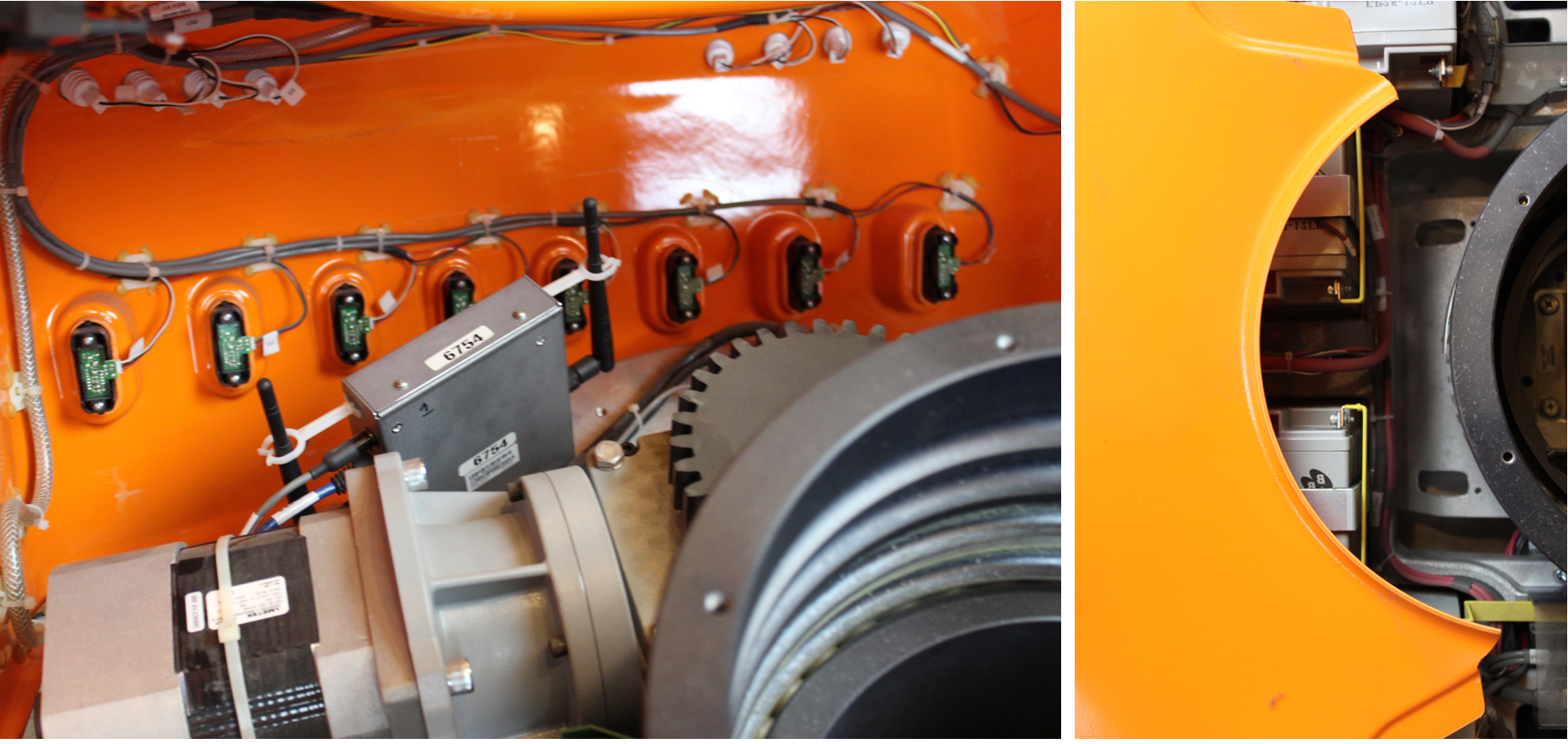
On the left: peeking into the front shell (including IR sensor array, wireless module, lifter and lifter motor). On the right: top of the lifter and the battery bank as the rear shell comes off.Each IR sensor has it’s own filter logic built-in and communicates over a serial bus. You can also see the wireless control module and the lifter motor and giant pinion gear. Towards the rear of the bot, there are four lead-acid batteries and high-amperage bus bars.
左侧:窥视前壳(包括红外传感器阵列,无线模块,提升器和提升器马达)。右侧:后壳脱落时,升降机和电池组的顶部。每个红外传感器都内置有自己的滤波器逻辑,并通过串行总线进行通信。您还可以看到无线控制模块以及升降机马达和大齿轮。在机器人的后部,有四个铅酸电池和高电流母线。
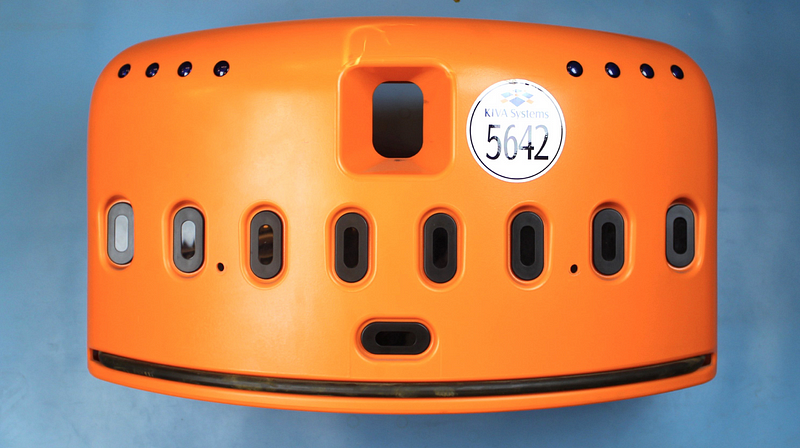
Both fairing halves are made from vacuum-formed ABS. There are a large number of features which can only be made by multiple secondary machining setups. Both the vacuum former and the CNC mill/router used to make these parts must be extremely large. This part is complex/expensive enough that I’d be surprised if later revisions of the Kiva bot aren’t injection molded.
两个整流罩半部均由真空成型的ABS制成。有许多功能只能通过多个辅助加工设置来实现。用于制造这些零件的真空成型机和CNC铣床/铣刨机都必须非常大。这部分非常复杂/昂贵,如果不对Kiva bot的更高版本进行注塑成型,我会感到惊讶。
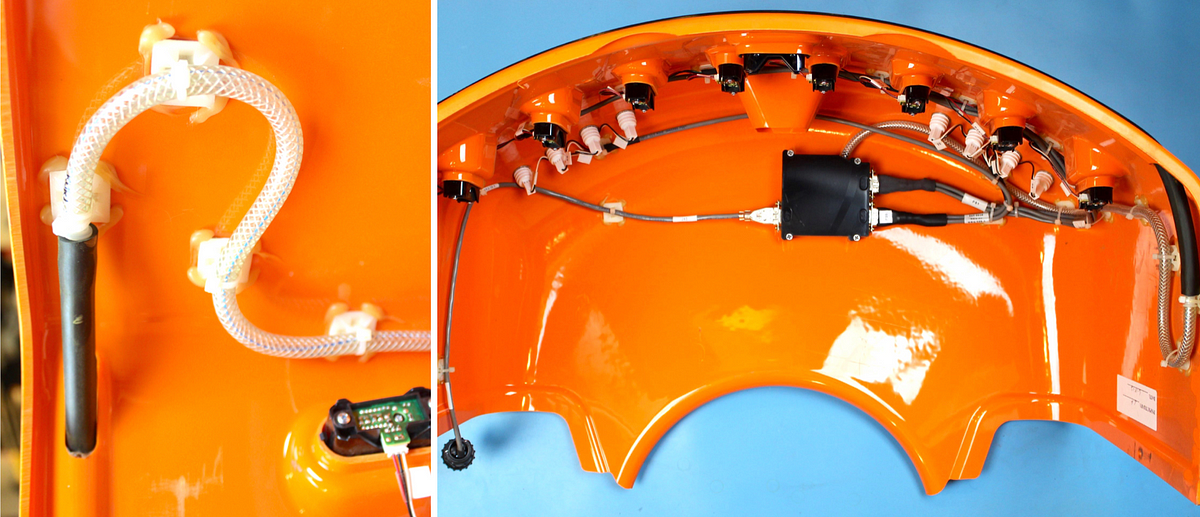 Brilliant bump sensor is super reliable and cost-effective for outfitting a large curved surface.Rather than building full-length bump sensors, which is notoriously difficult to do on curved surfaces like those on the front/back of the bot, Kiva engineers found a simple, cost effective solution. They utilized vinyl/rubber tubing and a simple pressure sensor so that as soon as a change in pressure is detected, the robot stops all movement. The black box in the right picture receives the pressure line and aggregates all the IR sensors to simplify the protocol and wiring to the main controller.
Brilliant bump sensor is super reliable and cost-effective for outfitting a large curved surface.Rather than building full-length bump sensors, which is notoriously difficult to do on curved surfaces like those on the front/back of the bot, Kiva engineers found a simple, cost effective solution. They utilized vinyl/rubber tubing and a simple pressure sensor so that as soon as a change in pressure is detected, the robot stops all movement. The black box in the right picture receives the pressure line and aggregates all the IR sensors to simplify the protocol and wiring to the main controller.
Kiva工程师没有建立全长的凹凸传感器,而众所周知,凹凸传感器很难在机器人前/后表面等弯曲表面上加工,而是找到了一种简单且经济高效的解决方案。他们利用乙烯基/橡胶管和简单的压力传感器,以便一旦检测到压力变化,机器人就会停止所有运动。右图中的黑框接收压力线并聚集所有IR传感器,以简化协议并连接至主控制器。
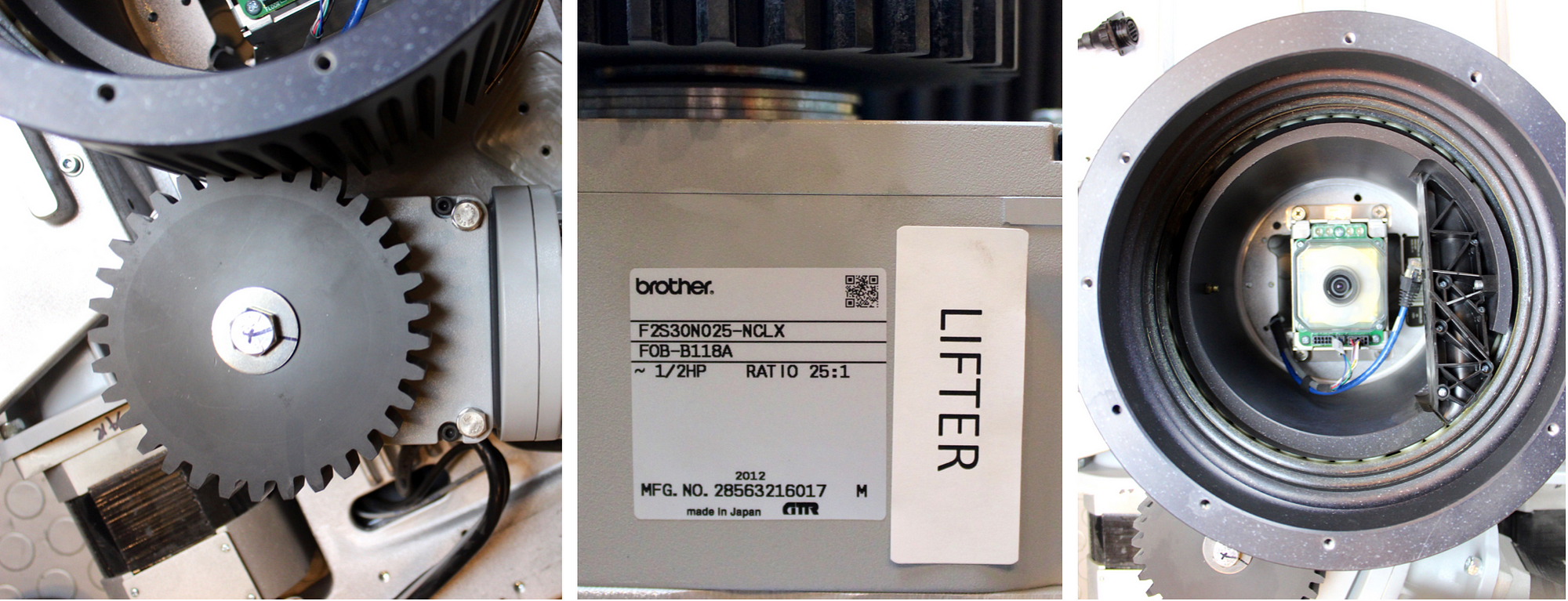 On the left: top view of ball screw and lifter pinion gear. In the middle: side view of lifter motor and gearbox. On the right: center view of the lifter ball screw with imaging module and programming cable inside.The lifter mechanism uses a custom-designed ball screw (the single most complex and expensive component, more on that later) coupled to a standard nylon pinion gear and gearmotor (the same one used for all three axes of motion). The motor is built by Pittman (Ametek) and boasts 27 in-lbs of torque and stall power of almost 1Kw. The right-angle bi-directional gearbox is built by Brother in Japan and can handle 407 in-lbs of torque at 72rpm with a 25:1 reduction. This motor gearbox combo runs into the $1,000 range for a single set (likely much lower at volume). Holy drivetrain, Batman!
On the left: top view of ball screw and lifter pinion gear. In the middle: side view of lifter motor and gearbox. On the right: center view of the lifter ball screw with imaging module and programming cable inside.The lifter mechanism uses a custom-designed ball screw (the single most complex and expensive component, more on that later) coupled to a standard nylon pinion gear and gearmotor (the same one used for all three axes of motion). The motor is built by Pittman (Ametek) and boasts 27 in-lbs of torque and stall power of almost 1Kw. The right-angle bi-directional gearbox is built by Brother in Japan and can handle 407 in-lbs of torque at 72rpm with a 25:1 reduction. This motor gearbox combo runs into the $1,000 range for a single set (likely much lower at volume). Holy drivetrain, Batman!
左侧:滚珠丝杠和升降器小齿轮的俯视图。中间:升降机马达和变速箱的侧视图。右侧:带有成像模块和编程电缆的提升器滚珠丝杠的中心视图。提升机构使用定制设计的滚珠丝杠(单个最复杂,最昂贵的组件,后面会详细介绍),并与标准的尼龙小齿轮和齿轮电动机(用于所有三个运动轴的相同)耦合。该电动机由Pittman(Ametek)制造,并具有27 in-lbs的扭矩和近1Kw的失速功率。直角双向变速箱由日本Brother制造,可在72rpm的转速下以25:1的速度处理407英寸-磅的扭矩。这款电机变速箱组合的单套价格为1,000美元(批量可能更低)。神圣的传动系统,蝙蝠侠!
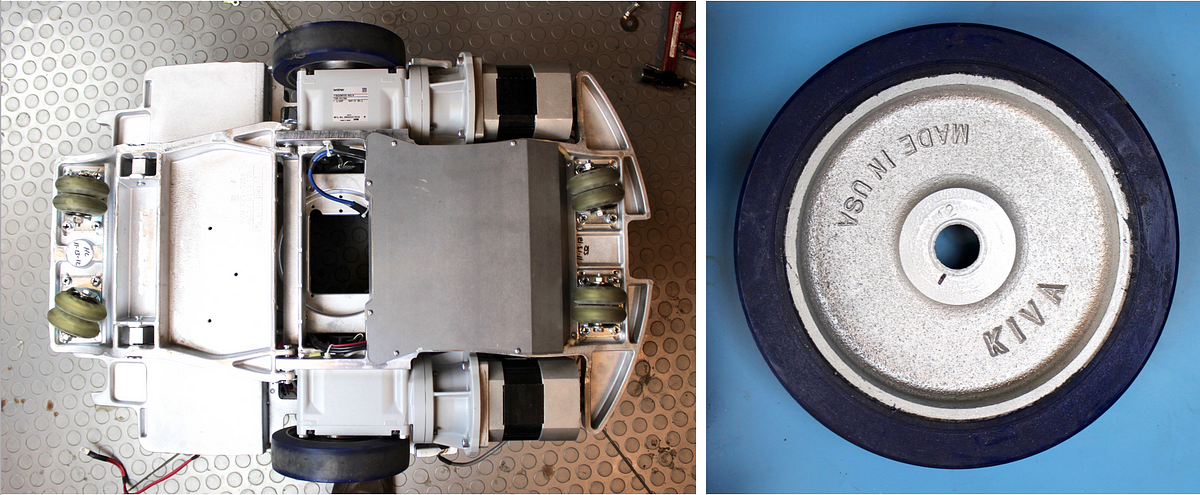 On the left: the underside of our bot, the main logic board is tucked away under that sheet steel panel. On the right: custom cast Kiva wheels likely designed for extreme durability on poured concrete floors.Once the lifter and electronics have been removed, the bot can be flipped over to get a better look at the drivetrain. Here we see the same two motors and gearboxes paired with custom-designed cast Kiva wheels. Flanked on either end are two pairs of dual rollerblade-style 360 degree casters. This drivetrain setup supports zero radius turns.
On the left: the underside of our bot, the main logic board is tucked away under that sheet steel panel. On the right: custom cast Kiva wheels likely designed for extreme durability on poured concrete floors.Once the lifter and electronics have been removed, the bot can be flipped over to get a better look at the drivetrain. Here we see the same two motors and gearboxes paired with custom-designed cast Kiva wheels. Flanked on either end are two pairs of dual rollerblade-style 360 degree casters. This drivetrain setup supports zero radius turns.
左侧:我们机器人的底面,主逻辑板隐藏在该钢板面板下方。右侧:定制的Kiva铸造车轮可能设计为在浇筑的混凝土地板上具有极高的耐用性。卸下升降机和电子设备后,可以将机器人翻转过来,以更好地查看传动系统。在这里,我们看到了相同的两个电动机和变速箱,以及定制设计的铸造Kiva车轮。两侧的两侧是两对双轮滑式360度脚轮。该传动系统设置支持零半径转弯。

Three sandcast aluminum parts make up the majority of the body and are joined with simple clevis pins to make a simple, passive double suspension action. They all use the same general purpose 319 alloy and are all post-machined after casting. Kiva engineers likely switched to low-pressure aluminum molding with permanent steel tools as production volume increased. Notice the cooling fins on the top of the front casting on the bottom right: the giant MOSFETs for the custom motor control circuits are resting against the backside of those fins for maximum thermal efficiency, a slick design decision.
主体的大部分由三个沙铸铝部件组成,并通过简单的U形销连接,从而实现了简单,被动的双重悬架动作。它们都使用相同的通用319合金,并且都在铸造后进行后加工。随着产量的增加,Kiva的工程师可能会转向使用永久钢工具的低压铝铸件。注意右下方前铸件顶部的散热片:用于定制电机控制电路的巨型MOSFET靠在这些散热片的背面,以实现最大的热效率,这是一个明智的设计决策。

On the left/center: clevis pins are used to simplify the suspension design. On the right: cast-in-place cooling fans opposite the motor controller FETS on the main logic board.### Electronics
Even though Kiva bots have nearly no decision-making authority (each move is controlled by servers in the cloud), movement of the bot while lifting and controlling thousands of pounds of merchandise requires
